Alibaba Goes Public: Financial and Strategic Analysis Report
VerifiedAdded on 2019/12/03
|50
|14542
|46
Report
AI Summary
This report provides a comprehensive analysis of Alibaba's initial public offering (IPO), examining the company's strategic decisions, financial performance, and market position. The study begins with an introduction that outlines the background of Alibaba, terms of reference, research aims and objectives, scope, map of the report, and limitations. It then presents a case brief detailing Alibaba's history and key milestones, followed by a problem statement that identifies the challenges faced by the company. The report also includes a literature review, proposed plan of analysis, sources of data, and ethical considerations. Findings and analysis cover an assessment of the current position, alternative business scenarios, and resource constraints. The study proposes solutions to identified problems, including an integrated discussion analysis, recommendations, and a proposed plan for action. It also addresses critical assumptions for success and implications for stakeholders. The application of learning includes a description of a comparator company's situation and testing the recommendations on that company. Financial ratios, SWOT analysis, and WACC calculations are used to evaluate Alibaba's performance and make recommendations. The report concludes with a discussion of limitations and suggestions for future research.

ALIBABA GOES PUBLIC
1
1
Paraphrase This Document
Need a fresh take? Get an instant paraphrase of this document with our AI Paraphraser
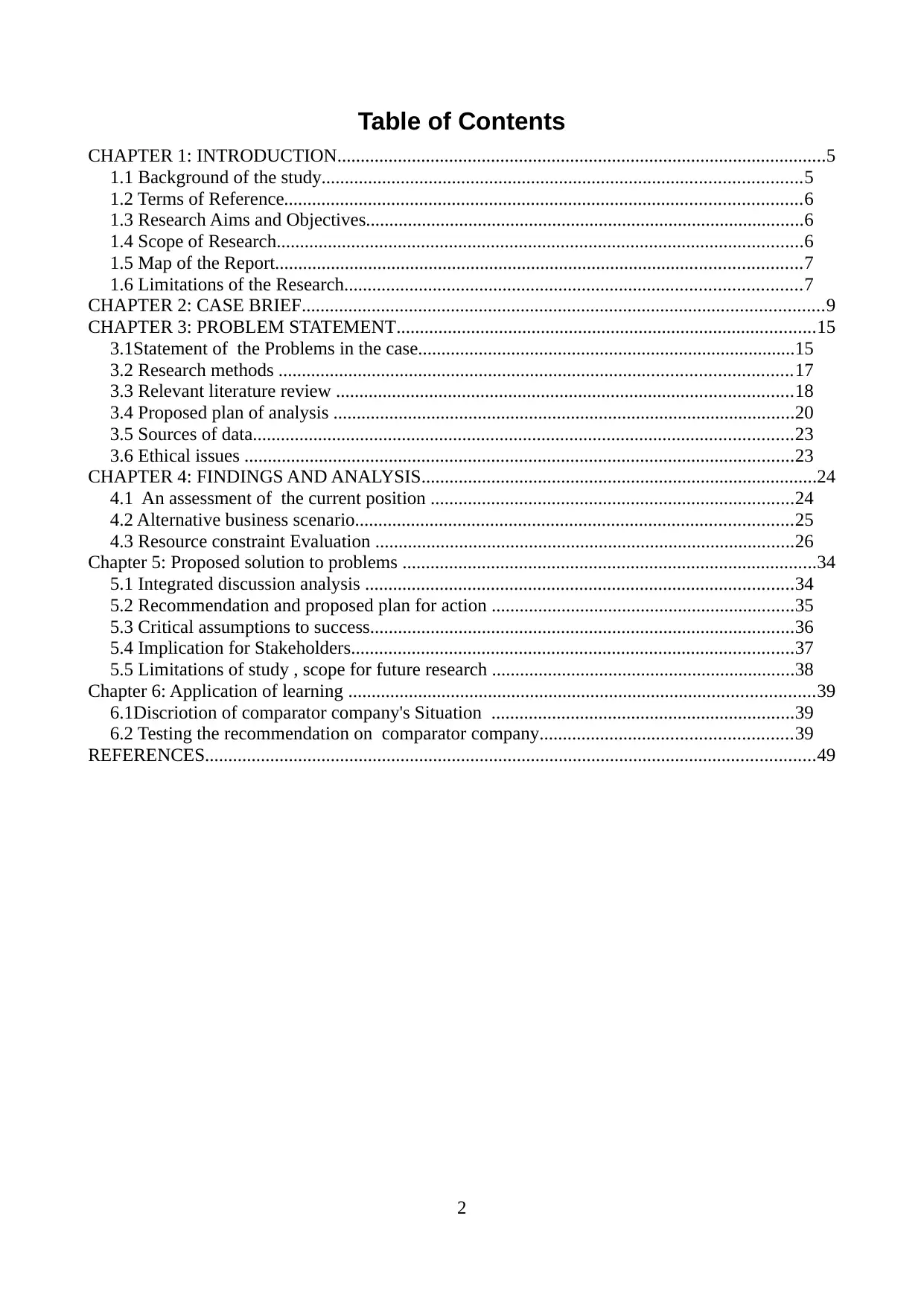
Table of Contents
CHAPTER 1: INTRODUCTION.........................................................................................................5
1.1 Background of the study.......................................................................................................5
1.2 Terms of Reference...............................................................................................................6
1.3 Research Aims and Objectives..............................................................................................6
1.4 Scope of Research.................................................................................................................6
1.5 Map of the Report.................................................................................................................7
1.6 Limitations of the Research..................................................................................................7
CHAPTER 2: CASE BRIEF................................................................................................................9
CHAPTER 3: PROBLEM STATEMENT..........................................................................................15
3.1Statement of the Problems in the case.................................................................................15
3.2 Research methods ..............................................................................................................17
3.3 Relevant literature review ..................................................................................................18
3.4 Proposed plan of analysis ...................................................................................................20
3.5 Sources of data....................................................................................................................23
3.6 Ethical issues ......................................................................................................................23
CHAPTER 4: FINDINGS AND ANALYSIS.....................................................................................24
4.1 An assessment of the current position ..............................................................................24
4.2 Alternative business scenario..............................................................................................25
4.3 Resource constraint Evaluation ..........................................................................................26
Chapter 5: Proposed solution to problems .........................................................................................34
5.1 Integrated discussion analysis ............................................................................................34
5.2 Recommendation and proposed plan for action .................................................................35
5.3 Critical assumptions to success...........................................................................................36
5.4 Implication for Stakeholders...............................................................................................37
5.5 Limitations of study , scope for future research .................................................................38
Chapter 6: Application of learning ....................................................................................................39
6.1Discriotion of comparator company's Situation .................................................................39
6.2 Testing the recommendation on comparator company......................................................39
REFERENCES...................................................................................................................................49
2
CHAPTER 1: INTRODUCTION.........................................................................................................5
1.1 Background of the study.......................................................................................................5
1.2 Terms of Reference...............................................................................................................6
1.3 Research Aims and Objectives..............................................................................................6
1.4 Scope of Research.................................................................................................................6
1.5 Map of the Report.................................................................................................................7
1.6 Limitations of the Research..................................................................................................7
CHAPTER 2: CASE BRIEF................................................................................................................9
CHAPTER 3: PROBLEM STATEMENT..........................................................................................15
3.1Statement of the Problems in the case.................................................................................15
3.2 Research methods ..............................................................................................................17
3.3 Relevant literature review ..................................................................................................18
3.4 Proposed plan of analysis ...................................................................................................20
3.5 Sources of data....................................................................................................................23
3.6 Ethical issues ......................................................................................................................23
CHAPTER 4: FINDINGS AND ANALYSIS.....................................................................................24
4.1 An assessment of the current position ..............................................................................24
4.2 Alternative business scenario..............................................................................................25
4.3 Resource constraint Evaluation ..........................................................................................26
Chapter 5: Proposed solution to problems .........................................................................................34
5.1 Integrated discussion analysis ............................................................................................34
5.2 Recommendation and proposed plan for action .................................................................35
5.3 Critical assumptions to success...........................................................................................36
5.4 Implication for Stakeholders...............................................................................................37
5.5 Limitations of study , scope for future research .................................................................38
Chapter 6: Application of learning ....................................................................................................39
6.1Discriotion of comparator company's Situation .................................................................39
6.2 Testing the recommendation on comparator company......................................................39
REFERENCES...................................................................................................................................49
2
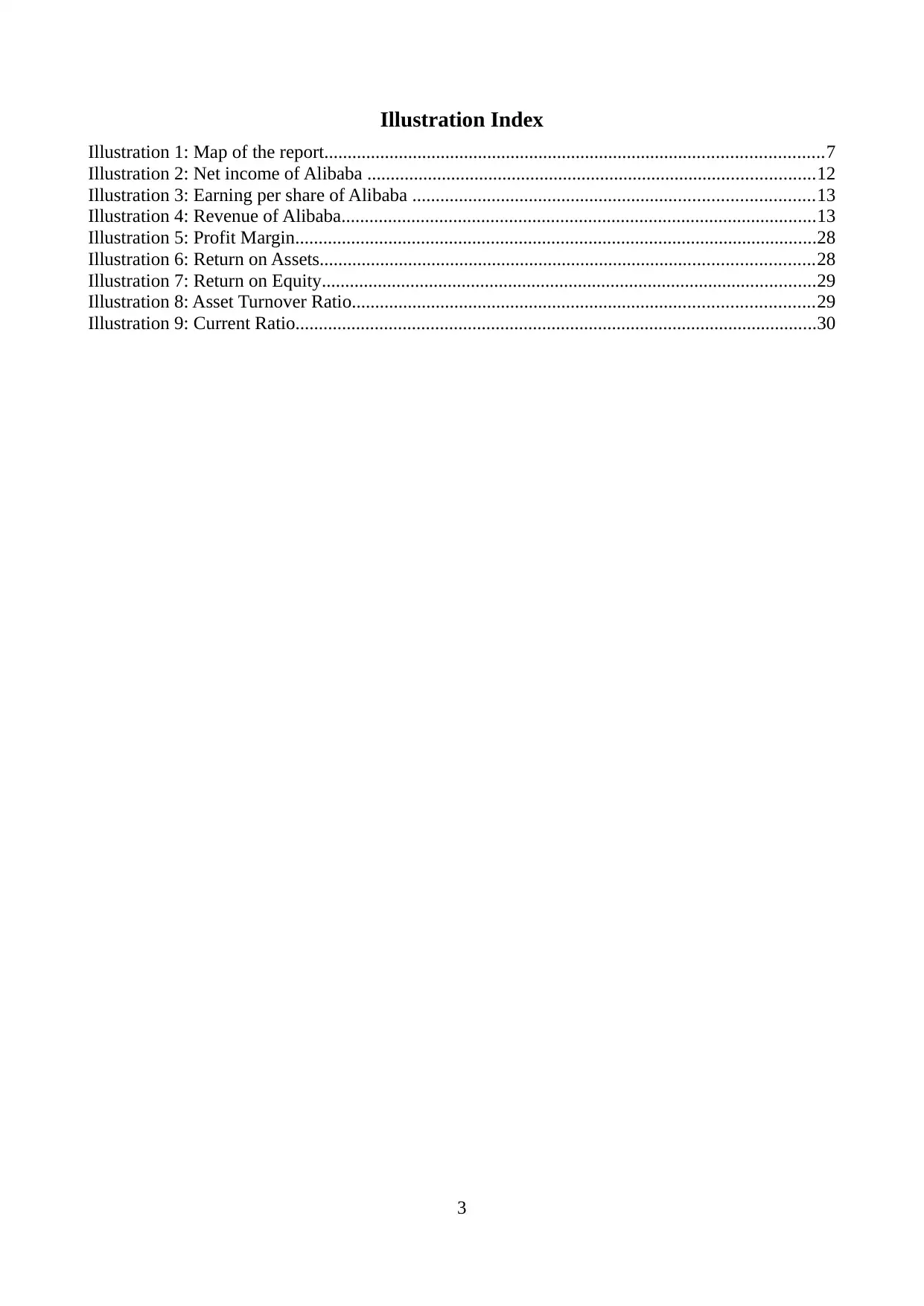
Illustration Index
Illustration 1: Map of the report...........................................................................................................7
Illustration 2: Net income of Alibaba ................................................................................................12
Illustration 3: Earning per share of Alibaba ......................................................................................13
Illustration 4: Revenue of Alibaba......................................................................................................13
Illustration 5: Profit Margin................................................................................................................28
Illustration 6: Return on Assets..........................................................................................................28
Illustration 7: Return on Equity..........................................................................................................29
Illustration 8: Asset Turnover Ratio...................................................................................................29
Illustration 9: Current Ratio................................................................................................................30
3
Illustration 1: Map of the report...........................................................................................................7
Illustration 2: Net income of Alibaba ................................................................................................12
Illustration 3: Earning per share of Alibaba ......................................................................................13
Illustration 4: Revenue of Alibaba......................................................................................................13
Illustration 5: Profit Margin................................................................................................................28
Illustration 6: Return on Assets..........................................................................................................28
Illustration 7: Return on Equity..........................................................................................................29
Illustration 8: Asset Turnover Ratio...................................................................................................29
Illustration 9: Current Ratio................................................................................................................30
3
⊘ This is a preview!⊘
Do you want full access?
Subscribe today to unlock all pages.

Trusted by 1+ million students worldwide
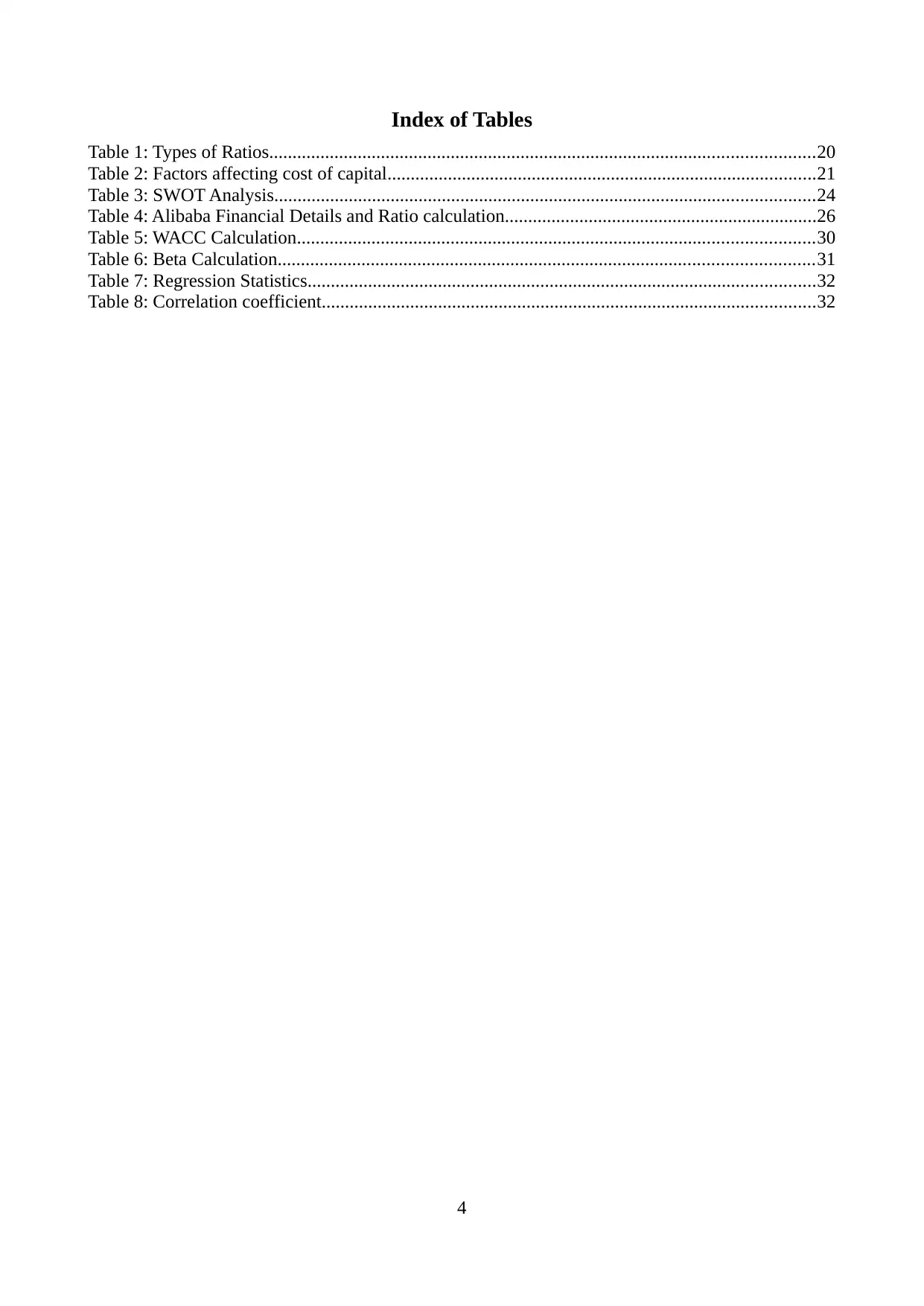
Index of Tables
Table 1: Types of Ratios.....................................................................................................................20
Table 2: Factors affecting cost of capital............................................................................................21
Table 3: SWOT Analysis....................................................................................................................24
Table 4: Alibaba Financial Details and Ratio calculation...................................................................26
Table 5: WACC Calculation...............................................................................................................30
Table 6: Beta Calculation...................................................................................................................31
Table 7: Regression Statistics.............................................................................................................32
Table 8: Correlation coefficient..........................................................................................................32
4
Table 1: Types of Ratios.....................................................................................................................20
Table 2: Factors affecting cost of capital............................................................................................21
Table 3: SWOT Analysis....................................................................................................................24
Table 4: Alibaba Financial Details and Ratio calculation...................................................................26
Table 5: WACC Calculation...............................................................................................................30
Table 6: Beta Calculation...................................................................................................................31
Table 7: Regression Statistics.............................................................................................................32
Table 8: Correlation coefficient..........................................................................................................32
4
Paraphrase This Document
Need a fresh take? Get an instant paraphrase of this document with our AI Paraphraser
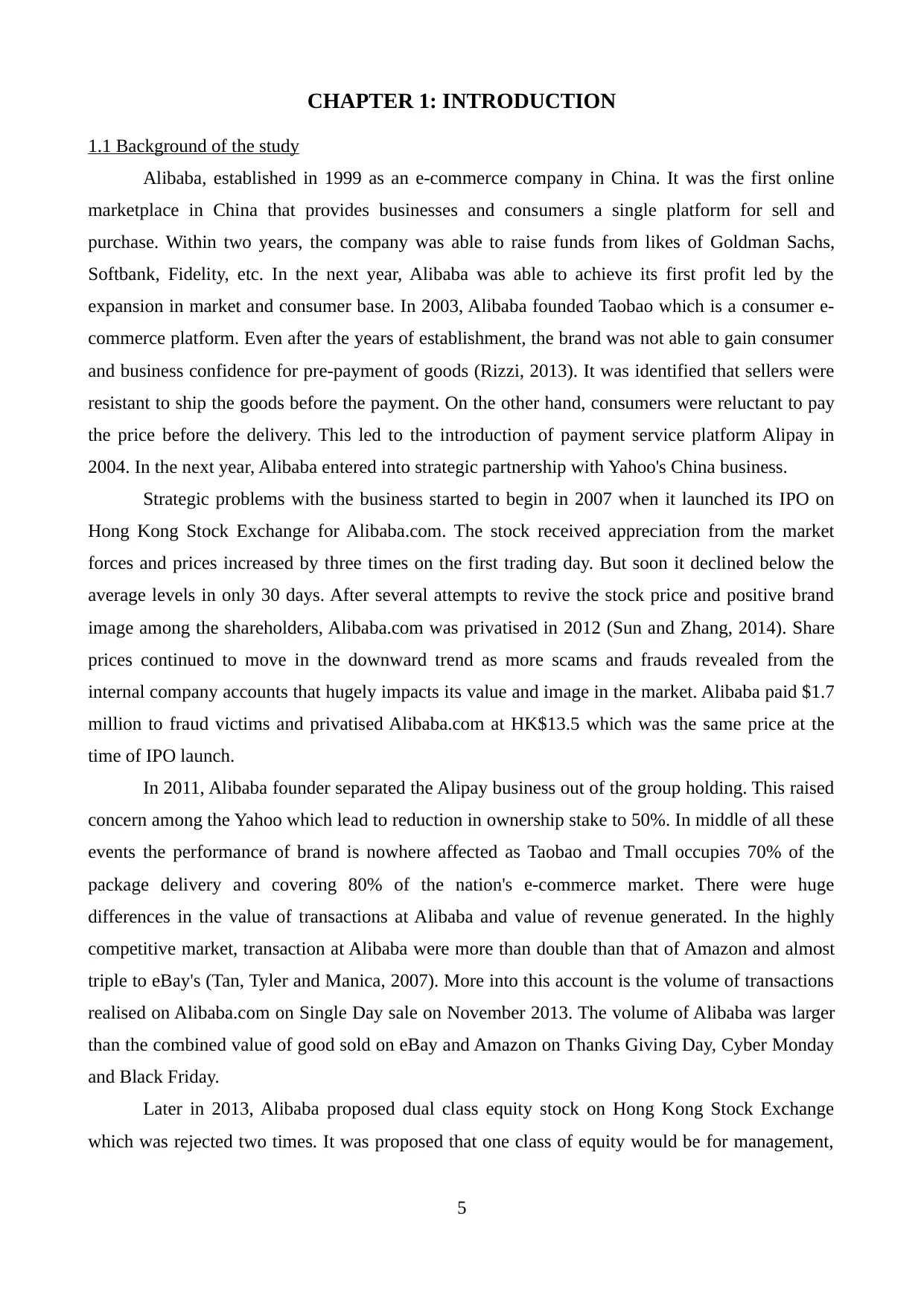
CHAPTER 1: INTRODUCTION
1.1 Background of the study
Alibaba, established in 1999 as an e-commerce company in China. It was the first online
marketplace in China that provides businesses and consumers a single platform for sell and
purchase. Within two years, the company was able to raise funds from likes of Goldman Sachs,
Softbank, Fidelity, etc. In the next year, Alibaba was able to achieve its first profit led by the
expansion in market and consumer base. In 2003, Alibaba founded Taobao which is a consumer e-
commerce platform. Even after the years of establishment, the brand was not able to gain consumer
and business confidence for pre-payment of goods (Rizzi, 2013). It was identified that sellers were
resistant to ship the goods before the payment. On the other hand, consumers were reluctant to pay
the price before the delivery. This led to the introduction of payment service platform Alipay in
2004. In the next year, Alibaba entered into strategic partnership with Yahoo's China business.
Strategic problems with the business started to begin in 2007 when it launched its IPO on
Hong Kong Stock Exchange for Alibaba.com. The stock received appreciation from the market
forces and prices increased by three times on the first trading day. But soon it declined below the
average levels in only 30 days. After several attempts to revive the stock price and positive brand
image among the shareholders, Alibaba.com was privatised in 2012 (Sun and Zhang, 2014). Share
prices continued to move in the downward trend as more scams and frauds revealed from the
internal company accounts that hugely impacts its value and image in the market. Alibaba paid $1.7
million to fraud victims and privatised Alibaba.com at HK$13.5 which was the same price at the
time of IPO launch.
In 2011, Alibaba founder separated the Alipay business out of the group holding. This raised
concern among the Yahoo which lead to reduction in ownership stake to 50%. In middle of all these
events the performance of brand is nowhere affected as Taobao and Tmall occupies 70% of the
package delivery and covering 80% of the nation's e-commerce market. There were huge
differences in the value of transactions at Alibaba and value of revenue generated. In the highly
competitive market, transaction at Alibaba were more than double than that of Amazon and almost
triple to eBay's (Tan, Tyler and Manica, 2007). More into this account is the volume of transactions
realised on Alibaba.com on Single Day sale on November 2013. The volume of Alibaba was larger
than the combined value of good sold on eBay and Amazon on Thanks Giving Day, Cyber Monday
and Black Friday.
Later in 2013, Alibaba proposed dual class equity stock on Hong Kong Stock Exchange
which was rejected two times. It was proposed that one class of equity would be for management,
5
1.1 Background of the study
Alibaba, established in 1999 as an e-commerce company in China. It was the first online
marketplace in China that provides businesses and consumers a single platform for sell and
purchase. Within two years, the company was able to raise funds from likes of Goldman Sachs,
Softbank, Fidelity, etc. In the next year, Alibaba was able to achieve its first profit led by the
expansion in market and consumer base. In 2003, Alibaba founded Taobao which is a consumer e-
commerce platform. Even after the years of establishment, the brand was not able to gain consumer
and business confidence for pre-payment of goods (Rizzi, 2013). It was identified that sellers were
resistant to ship the goods before the payment. On the other hand, consumers were reluctant to pay
the price before the delivery. This led to the introduction of payment service platform Alipay in
2004. In the next year, Alibaba entered into strategic partnership with Yahoo's China business.
Strategic problems with the business started to begin in 2007 when it launched its IPO on
Hong Kong Stock Exchange for Alibaba.com. The stock received appreciation from the market
forces and prices increased by three times on the first trading day. But soon it declined below the
average levels in only 30 days. After several attempts to revive the stock price and positive brand
image among the shareholders, Alibaba.com was privatised in 2012 (Sun and Zhang, 2014). Share
prices continued to move in the downward trend as more scams and frauds revealed from the
internal company accounts that hugely impacts its value and image in the market. Alibaba paid $1.7
million to fraud victims and privatised Alibaba.com at HK$13.5 which was the same price at the
time of IPO launch.
In 2011, Alibaba founder separated the Alipay business out of the group holding. This raised
concern among the Yahoo which lead to reduction in ownership stake to 50%. In middle of all these
events the performance of brand is nowhere affected as Taobao and Tmall occupies 70% of the
package delivery and covering 80% of the nation's e-commerce market. There were huge
differences in the value of transactions at Alibaba and value of revenue generated. In the highly
competitive market, transaction at Alibaba were more than double than that of Amazon and almost
triple to eBay's (Tan, Tyler and Manica, 2007). More into this account is the volume of transactions
realised on Alibaba.com on Single Day sale on November 2013. The volume of Alibaba was larger
than the combined value of good sold on eBay and Amazon on Thanks Giving Day, Cyber Monday
and Black Friday.
Later in 2013, Alibaba proposed dual class equity stock on Hong Kong Stock Exchange
which was rejected two times. It was proposed that one class of equity would be for management,
5
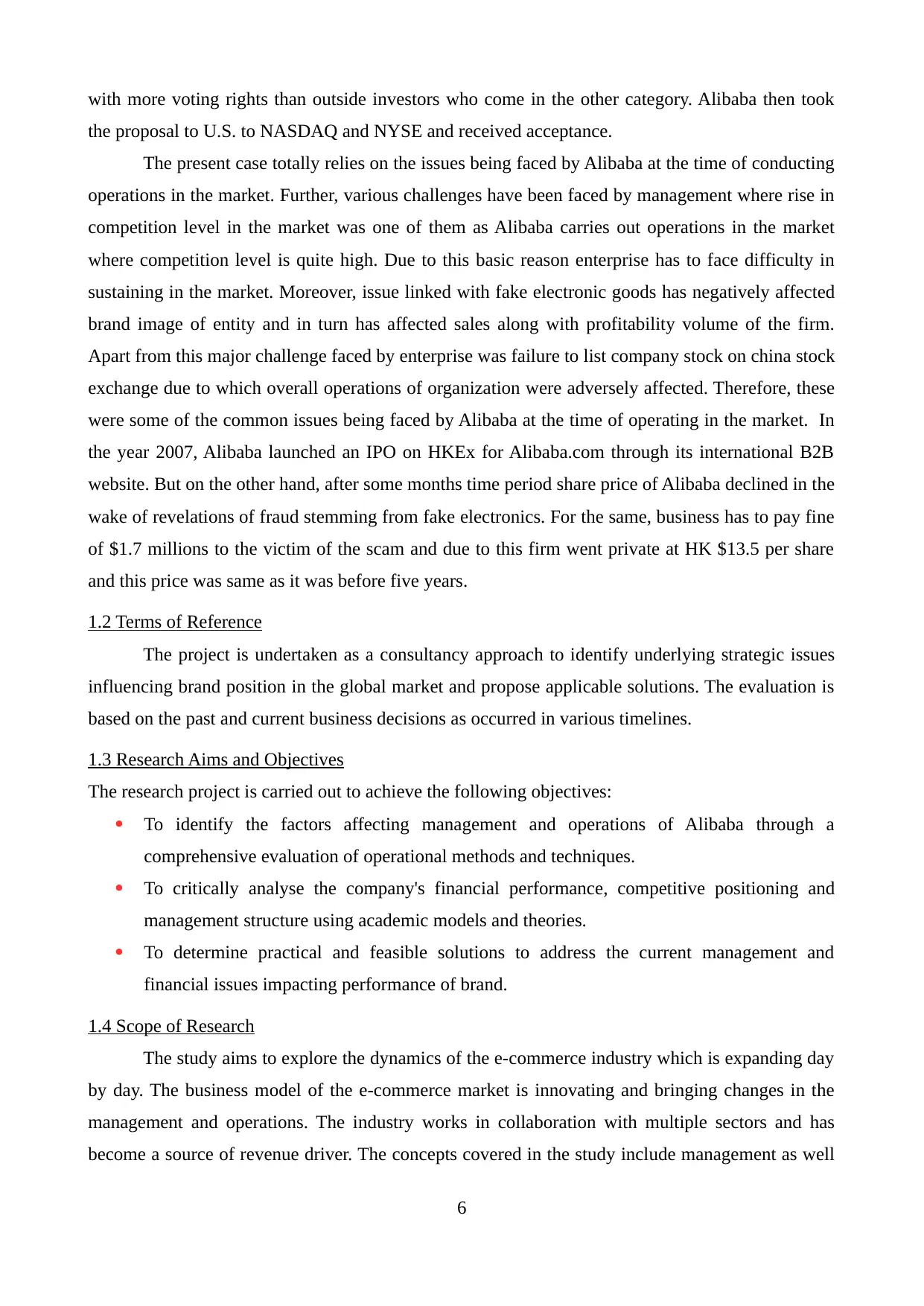
with more voting rights than outside investors who come in the other category. Alibaba then took
the proposal to U.S. to NASDAQ and NYSE and received acceptance.
The present case totally relies on the issues being faced by Alibaba at the time of conducting
operations in the market. Further, various challenges have been faced by management where rise in
competition level in the market was one of them as Alibaba carries out operations in the market
where competition level is quite high. Due to this basic reason enterprise has to face difficulty in
sustaining in the market. Moreover, issue linked with fake electronic goods has negatively affected
brand image of entity and in turn has affected sales along with profitability volume of the firm.
Apart from this major challenge faced by enterprise was failure to list company stock on china stock
exchange due to which overall operations of organization were adversely affected. Therefore, these
were some of the common issues being faced by Alibaba at the time of operating in the market. In
the year 2007, Alibaba launched an IPO on HKEx for Alibaba.com through its international B2B
website. But on the other hand, after some months time period share price of Alibaba declined in the
wake of revelations of fraud stemming from fake electronics. For the same, business has to pay fine
of $1.7 millions to the victim of the scam and due to this firm went private at HK $13.5 per share
and this price was same as it was before five years.
1.2 Terms of Reference
The project is undertaken as a consultancy approach to identify underlying strategic issues
influencing brand position in the global market and propose applicable solutions. The evaluation is
based on the past and current business decisions as occurred in various timelines.
1.3 Research Aims and Objectives
The research project is carried out to achieve the following objectives:
To identify the factors affecting management and operations of Alibaba through a
comprehensive evaluation of operational methods and techniques.
To critically analyse the company's financial performance, competitive positioning and
management structure using academic models and theories.
To determine practical and feasible solutions to address the current management and
financial issues impacting performance of brand.
1.4 Scope of Research
The study aims to explore the dynamics of the e-commerce industry which is expanding day
by day. The business model of the e-commerce market is innovating and bringing changes in the
management and operations. The industry works in collaboration with multiple sectors and has
become a source of revenue driver. The concepts covered in the study include management as well
6
the proposal to U.S. to NASDAQ and NYSE and received acceptance.
The present case totally relies on the issues being faced by Alibaba at the time of conducting
operations in the market. Further, various challenges have been faced by management where rise in
competition level in the market was one of them as Alibaba carries out operations in the market
where competition level is quite high. Due to this basic reason enterprise has to face difficulty in
sustaining in the market. Moreover, issue linked with fake electronic goods has negatively affected
brand image of entity and in turn has affected sales along with profitability volume of the firm.
Apart from this major challenge faced by enterprise was failure to list company stock on china stock
exchange due to which overall operations of organization were adversely affected. Therefore, these
were some of the common issues being faced by Alibaba at the time of operating in the market. In
the year 2007, Alibaba launched an IPO on HKEx for Alibaba.com through its international B2B
website. But on the other hand, after some months time period share price of Alibaba declined in the
wake of revelations of fraud stemming from fake electronics. For the same, business has to pay fine
of $1.7 millions to the victim of the scam and due to this firm went private at HK $13.5 per share
and this price was same as it was before five years.
1.2 Terms of Reference
The project is undertaken as a consultancy approach to identify underlying strategic issues
influencing brand position in the global market and propose applicable solutions. The evaluation is
based on the past and current business decisions as occurred in various timelines.
1.3 Research Aims and Objectives
The research project is carried out to achieve the following objectives:
To identify the factors affecting management and operations of Alibaba through a
comprehensive evaluation of operational methods and techniques.
To critically analyse the company's financial performance, competitive positioning and
management structure using academic models and theories.
To determine practical and feasible solutions to address the current management and
financial issues impacting performance of brand.
1.4 Scope of Research
The study aims to explore the dynamics of the e-commerce industry which is expanding day
by day. The business model of the e-commerce market is innovating and bringing changes in the
management and operations. The industry works in collaboration with multiple sectors and has
become a source of revenue driver. The concepts covered in the study include management as well
6
⊘ This is a preview!⊘
Do you want full access?
Subscribe today to unlock all pages.

Trusted by 1+ million students worldwide
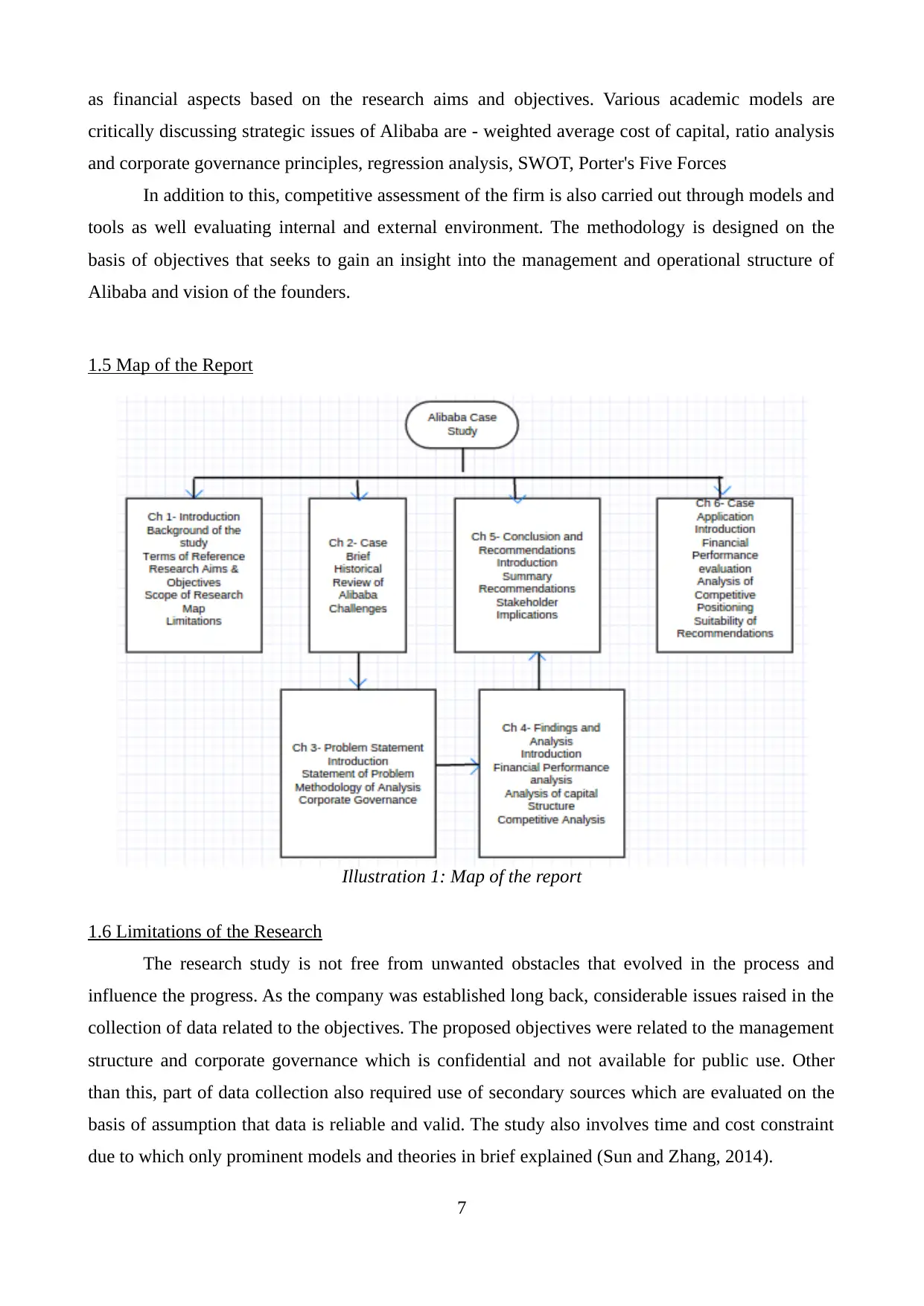
as financial aspects based on the research aims and objectives. Various academic models are
critically discussing strategic issues of Alibaba are - weighted average cost of capital, ratio analysis
and corporate governance principles, regression analysis, SWOT, Porter's Five Forces
In addition to this, competitive assessment of the firm is also carried out through models and
tools as well evaluating internal and external environment. The methodology is designed on the
basis of objectives that seeks to gain an insight into the management and operational structure of
Alibaba and vision of the founders.
1.5 Map of the Report
Illustration 1: Map of the report
1.6 Limitations of the Research
The research study is not free from unwanted obstacles that evolved in the process and
influence the progress. As the company was established long back, considerable issues raised in the
collection of data related to the objectives. The proposed objectives were related to the management
structure and corporate governance which is confidential and not available for public use. Other
than this, part of data collection also required use of secondary sources which are evaluated on the
basis of assumption that data is reliable and valid. The study also involves time and cost constraint
due to which only prominent models and theories in brief explained (Sun and Zhang, 2014).
7
critically discussing strategic issues of Alibaba are - weighted average cost of capital, ratio analysis
and corporate governance principles, regression analysis, SWOT, Porter's Five Forces
In addition to this, competitive assessment of the firm is also carried out through models and
tools as well evaluating internal and external environment. The methodology is designed on the
basis of objectives that seeks to gain an insight into the management and operational structure of
Alibaba and vision of the founders.
1.5 Map of the Report
Illustration 1: Map of the report
1.6 Limitations of the Research
The research study is not free from unwanted obstacles that evolved in the process and
influence the progress. As the company was established long back, considerable issues raised in the
collection of data related to the objectives. The proposed objectives were related to the management
structure and corporate governance which is confidential and not available for public use. Other
than this, part of data collection also required use of secondary sources which are evaluated on the
basis of assumption that data is reliable and valid. The study also involves time and cost constraint
due to which only prominent models and theories in brief explained (Sun and Zhang, 2014).
7
Paraphrase This Document
Need a fresh take? Get an instant paraphrase of this document with our AI Paraphraser
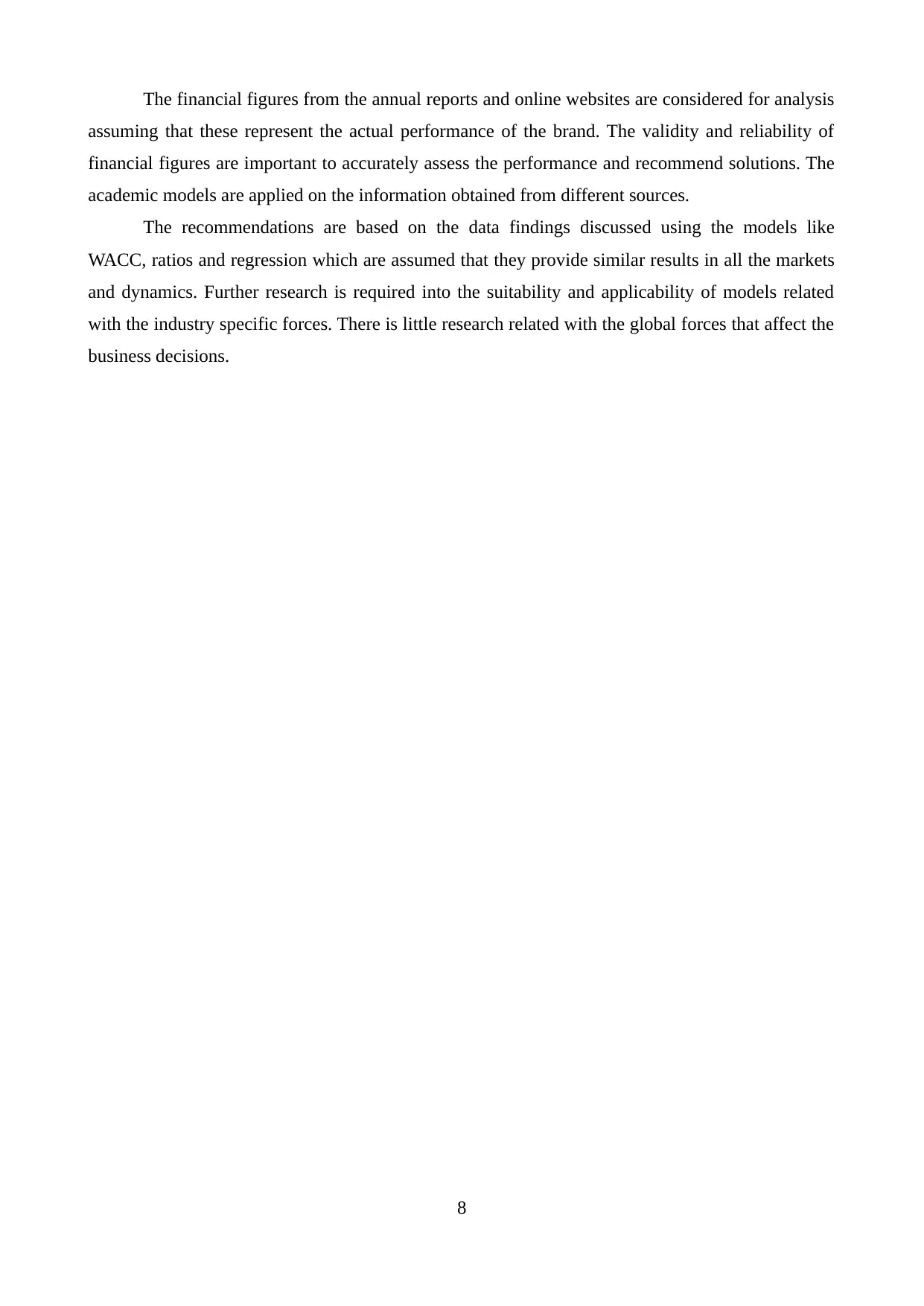
The financial figures from the annual reports and online websites are considered for analysis
assuming that these represent the actual performance of the brand. The validity and reliability of
financial figures are important to accurately assess the performance and recommend solutions. The
academic models are applied on the information obtained from different sources.
The recommendations are based on the data findings discussed using the models like
WACC, ratios and regression which are assumed that they provide similar results in all the markets
and dynamics. Further research is required into the suitability and applicability of models related
with the industry specific forces. There is little research related with the global forces that affect the
business decisions.
8
assuming that these represent the actual performance of the brand. The validity and reliability of
financial figures are important to accurately assess the performance and recommend solutions. The
academic models are applied on the information obtained from different sources.
The recommendations are based on the data findings discussed using the models like
WACC, ratios and regression which are assumed that they provide similar results in all the markets
and dynamics. Further research is required into the suitability and applicability of models related
with the industry specific forces. There is little research related with the global forces that affect the
business decisions.
8
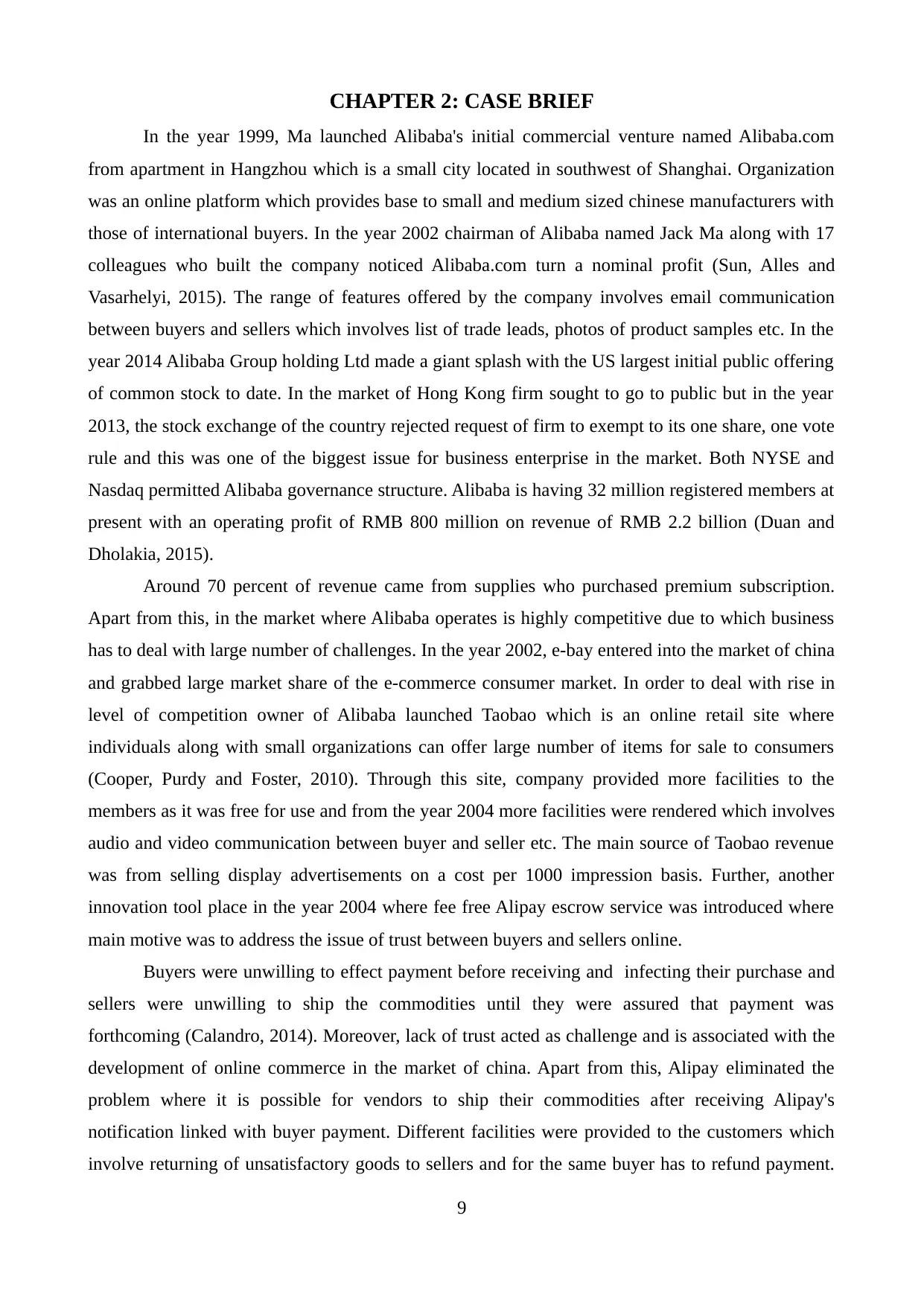
CHAPTER 2: CASE BRIEF
In the year 1999, Ma launched Alibaba's initial commercial venture named Alibaba.com
from apartment in Hangzhou which is a small city located in southwest of Shanghai. Organization
was an online platform which provides base to small and medium sized chinese manufacturers with
those of international buyers. In the year 2002 chairman of Alibaba named Jack Ma along with 17
colleagues who built the company noticed Alibaba.com turn a nominal profit (Sun, Alles and
Vasarhelyi, 2015). The range of features offered by the company involves email communication
between buyers and sellers which involves list of trade leads, photos of product samples etc. In the
year 2014 Alibaba Group holding Ltd made a giant splash with the US largest initial public offering
of common stock to date. In the market of Hong Kong firm sought to go to public but in the year
2013, the stock exchange of the country rejected request of firm to exempt to its one share, one vote
rule and this was one of the biggest issue for business enterprise in the market. Both NYSE and
Nasdaq permitted Alibaba governance structure. Alibaba is having 32 million registered members at
present with an operating profit of RMB 800 million on revenue of RMB 2.2 billion (Duan and
Dholakia, 2015).
Around 70 percent of revenue came from supplies who purchased premium subscription.
Apart from this, in the market where Alibaba operates is highly competitive due to which business
has to deal with large number of challenges. In the year 2002, e-bay entered into the market of china
and grabbed large market share of the e-commerce consumer market. In order to deal with rise in
level of competition owner of Alibaba launched Taobao which is an online retail site where
individuals along with small organizations can offer large number of items for sale to consumers
(Cooper, Purdy and Foster, 2010). Through this site, company provided more facilities to the
members as it was free for use and from the year 2004 more facilities were rendered which involves
audio and video communication between buyer and seller etc. The main source of Taobao revenue
was from selling display advertisements on a cost per 1000 impression basis. Further, another
innovation tool place in the year 2004 where fee free Alipay escrow service was introduced where
main motive was to address the issue of trust between buyers and sellers online.
Buyers were unwilling to effect payment before receiving and infecting their purchase and
sellers were unwilling to ship the commodities until they were assured that payment was
forthcoming (Calandro, 2014). Moreover, lack of trust acted as challenge and is associated with the
development of online commerce in the market of china. Apart from this, Alipay eliminated the
problem where it is possible for vendors to ship their commodities after receiving Alipay's
notification linked with buyer payment. Different facilities were provided to the customers which
involve returning of unsatisfactory goods to sellers and for the same buyer has to refund payment.
9
In the year 1999, Ma launched Alibaba's initial commercial venture named Alibaba.com
from apartment in Hangzhou which is a small city located in southwest of Shanghai. Organization
was an online platform which provides base to small and medium sized chinese manufacturers with
those of international buyers. In the year 2002 chairman of Alibaba named Jack Ma along with 17
colleagues who built the company noticed Alibaba.com turn a nominal profit (Sun, Alles and
Vasarhelyi, 2015). The range of features offered by the company involves email communication
between buyers and sellers which involves list of trade leads, photos of product samples etc. In the
year 2014 Alibaba Group holding Ltd made a giant splash with the US largest initial public offering
of common stock to date. In the market of Hong Kong firm sought to go to public but in the year
2013, the stock exchange of the country rejected request of firm to exempt to its one share, one vote
rule and this was one of the biggest issue for business enterprise in the market. Both NYSE and
Nasdaq permitted Alibaba governance structure. Alibaba is having 32 million registered members at
present with an operating profit of RMB 800 million on revenue of RMB 2.2 billion (Duan and
Dholakia, 2015).
Around 70 percent of revenue came from supplies who purchased premium subscription.
Apart from this, in the market where Alibaba operates is highly competitive due to which business
has to deal with large number of challenges. In the year 2002, e-bay entered into the market of china
and grabbed large market share of the e-commerce consumer market. In order to deal with rise in
level of competition owner of Alibaba launched Taobao which is an online retail site where
individuals along with small organizations can offer large number of items for sale to consumers
(Cooper, Purdy and Foster, 2010). Through this site, company provided more facilities to the
members as it was free for use and from the year 2004 more facilities were rendered which involves
audio and video communication between buyer and seller etc. The main source of Taobao revenue
was from selling display advertisements on a cost per 1000 impression basis. Further, another
innovation tool place in the year 2004 where fee free Alipay escrow service was introduced where
main motive was to address the issue of trust between buyers and sellers online.
Buyers were unwilling to effect payment before receiving and infecting their purchase and
sellers were unwilling to ship the commodities until they were assured that payment was
forthcoming (Calandro, 2014). Moreover, lack of trust acted as challenge and is associated with the
development of online commerce in the market of china. Apart from this, Alipay eliminated the
problem where it is possible for vendors to ship their commodities after receiving Alipay's
notification linked with buyer payment. Different facilities were provided to the customers which
involve returning of unsatisfactory goods to sellers and for the same buyer has to refund payment.
9
⊘ This is a preview!⊘
Do you want full access?
Subscribe today to unlock all pages.

Trusted by 1+ million students worldwide
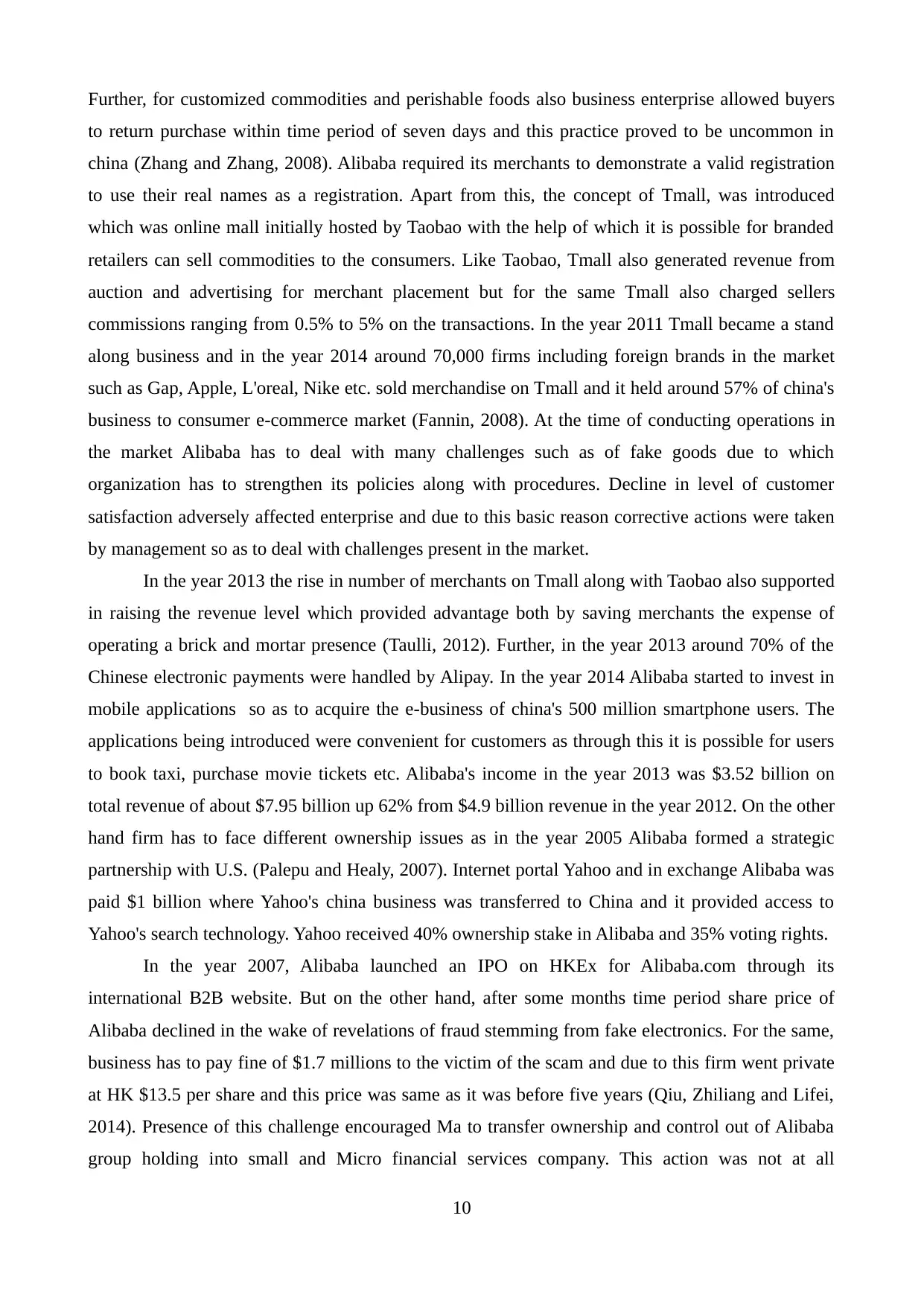
Further, for customized commodities and perishable foods also business enterprise allowed buyers
to return purchase within time period of seven days and this practice proved to be uncommon in
china (Zhang and Zhang, 2008). Alibaba required its merchants to demonstrate a valid registration
to use their real names as a registration. Apart from this, the concept of Tmall, was introduced
which was online mall initially hosted by Taobao with the help of which it is possible for branded
retailers can sell commodities to the consumers. Like Taobao, Tmall also generated revenue from
auction and advertising for merchant placement but for the same Tmall also charged sellers
commissions ranging from 0.5% to 5% on the transactions. In the year 2011 Tmall became a stand
along business and in the year 2014 around 70,000 firms including foreign brands in the market
such as Gap, Apple, L'oreal, Nike etc. sold merchandise on Tmall and it held around 57% of china's
business to consumer e-commerce market (Fannin, 2008). At the time of conducting operations in
the market Alibaba has to deal with many challenges such as of fake goods due to which
organization has to strengthen its policies along with procedures. Decline in level of customer
satisfaction adversely affected enterprise and due to this basic reason corrective actions were taken
by management so as to deal with challenges present in the market.
In the year 2013 the rise in number of merchants on Tmall along with Taobao also supported
in raising the revenue level which provided advantage both by saving merchants the expense of
operating a brick and mortar presence (Taulli, 2012). Further, in the year 2013 around 70% of the
Chinese electronic payments were handled by Alipay. In the year 2014 Alibaba started to invest in
mobile applications so as to acquire the e-business of china's 500 million smartphone users. The
applications being introduced were convenient for customers as through this it is possible for users
to book taxi, purchase movie tickets etc. Alibaba's income in the year 2013 was $3.52 billion on
total revenue of about $7.95 billion up 62% from $4.9 billion revenue in the year 2012. On the other
hand firm has to face different ownership issues as in the year 2005 Alibaba formed a strategic
partnership with U.S. (Palepu and Healy, 2007). Internet portal Yahoo and in exchange Alibaba was
paid $1 billion where Yahoo's china business was transferred to China and it provided access to
Yahoo's search technology. Yahoo received 40% ownership stake in Alibaba and 35% voting rights.
In the year 2007, Alibaba launched an IPO on HKEx for Alibaba.com through its
international B2B website. But on the other hand, after some months time period share price of
Alibaba declined in the wake of revelations of fraud stemming from fake electronics. For the same,
business has to pay fine of $1.7 millions to the victim of the scam and due to this firm went private
at HK $13.5 per share and this price was same as it was before five years (Qiu, Zhiliang and Lifei,
2014). Presence of this challenge encouraged Ma to transfer ownership and control out of Alibaba
group holding into small and Micro financial services company. This action was not at all
10
to return purchase within time period of seven days and this practice proved to be uncommon in
china (Zhang and Zhang, 2008). Alibaba required its merchants to demonstrate a valid registration
to use their real names as a registration. Apart from this, the concept of Tmall, was introduced
which was online mall initially hosted by Taobao with the help of which it is possible for branded
retailers can sell commodities to the consumers. Like Taobao, Tmall also generated revenue from
auction and advertising for merchant placement but for the same Tmall also charged sellers
commissions ranging from 0.5% to 5% on the transactions. In the year 2011 Tmall became a stand
along business and in the year 2014 around 70,000 firms including foreign brands in the market
such as Gap, Apple, L'oreal, Nike etc. sold merchandise on Tmall and it held around 57% of china's
business to consumer e-commerce market (Fannin, 2008). At the time of conducting operations in
the market Alibaba has to deal with many challenges such as of fake goods due to which
organization has to strengthen its policies along with procedures. Decline in level of customer
satisfaction adversely affected enterprise and due to this basic reason corrective actions were taken
by management so as to deal with challenges present in the market.
In the year 2013 the rise in number of merchants on Tmall along with Taobao also supported
in raising the revenue level which provided advantage both by saving merchants the expense of
operating a brick and mortar presence (Taulli, 2012). Further, in the year 2013 around 70% of the
Chinese electronic payments were handled by Alipay. In the year 2014 Alibaba started to invest in
mobile applications so as to acquire the e-business of china's 500 million smartphone users. The
applications being introduced were convenient for customers as through this it is possible for users
to book taxi, purchase movie tickets etc. Alibaba's income in the year 2013 was $3.52 billion on
total revenue of about $7.95 billion up 62% from $4.9 billion revenue in the year 2012. On the other
hand firm has to face different ownership issues as in the year 2005 Alibaba formed a strategic
partnership with U.S. (Palepu and Healy, 2007). Internet portal Yahoo and in exchange Alibaba was
paid $1 billion where Yahoo's china business was transferred to China and it provided access to
Yahoo's search technology. Yahoo received 40% ownership stake in Alibaba and 35% voting rights.
In the year 2007, Alibaba launched an IPO on HKEx for Alibaba.com through its
international B2B website. But on the other hand, after some months time period share price of
Alibaba declined in the wake of revelations of fraud stemming from fake electronics. For the same,
business has to pay fine of $1.7 millions to the victim of the scam and due to this firm went private
at HK $13.5 per share and this price was same as it was before five years (Qiu, Zhiliang and Lifei,
2014). Presence of this challenge encouraged Ma to transfer ownership and control out of Alibaba
group holding into small and Micro financial services company. This action was not at all
10
Paraphrase This Document
Need a fresh take? Get an instant paraphrase of this document with our AI Paraphraser
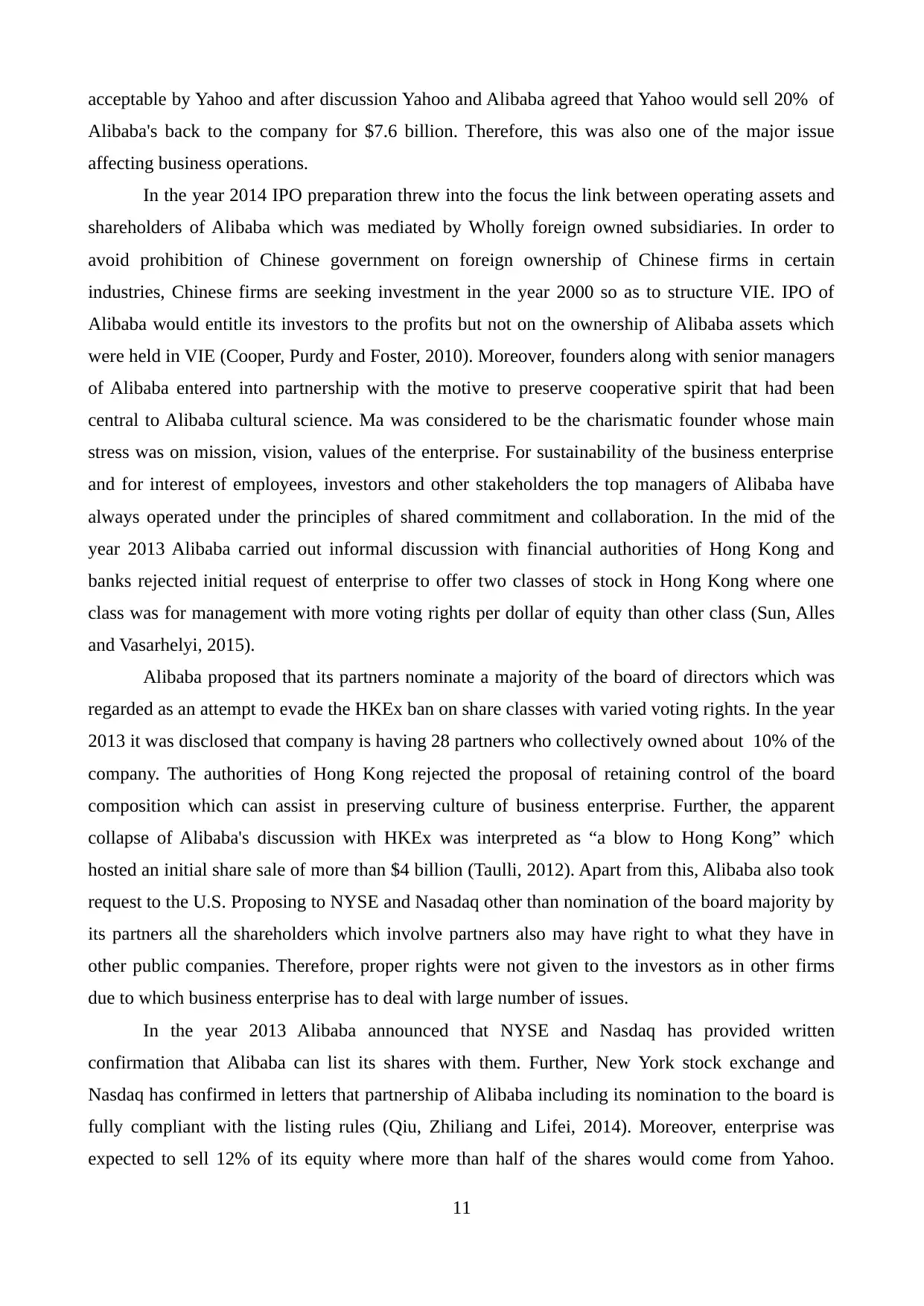
acceptable by Yahoo and after discussion Yahoo and Alibaba agreed that Yahoo would sell 20% of
Alibaba's back to the company for $7.6 billion. Therefore, this was also one of the major issue
affecting business operations.
In the year 2014 IPO preparation threw into the focus the link between operating assets and
shareholders of Alibaba which was mediated by Wholly foreign owned subsidiaries. In order to
avoid prohibition of Chinese government on foreign ownership of Chinese firms in certain
industries, Chinese firms are seeking investment in the year 2000 so as to structure VIE. IPO of
Alibaba would entitle its investors to the profits but not on the ownership of Alibaba assets which
were held in VIE (Cooper, Purdy and Foster, 2010). Moreover, founders along with senior managers
of Alibaba entered into partnership with the motive to preserve cooperative spirit that had been
central to Alibaba cultural science. Ma was considered to be the charismatic founder whose main
stress was on mission, vision, values of the enterprise. For sustainability of the business enterprise
and for interest of employees, investors and other stakeholders the top managers of Alibaba have
always operated under the principles of shared commitment and collaboration. In the mid of the
year 2013 Alibaba carried out informal discussion with financial authorities of Hong Kong and
banks rejected initial request of enterprise to offer two classes of stock in Hong Kong where one
class was for management with more voting rights per dollar of equity than other class (Sun, Alles
and Vasarhelyi, 2015).
Alibaba proposed that its partners nominate a majority of the board of directors which was
regarded as an attempt to evade the HKEx ban on share classes with varied voting rights. In the year
2013 it was disclosed that company is having 28 partners who collectively owned about 10% of the
company. The authorities of Hong Kong rejected the proposal of retaining control of the board
composition which can assist in preserving culture of business enterprise. Further, the apparent
collapse of Alibaba's discussion with HKEx was interpreted as “a blow to Hong Kong” which
hosted an initial share sale of more than $4 billion (Taulli, 2012). Apart from this, Alibaba also took
request to the U.S. Proposing to NYSE and Nasadaq other than nomination of the board majority by
its partners all the shareholders which involve partners also may have right to what they have in
other public companies. Therefore, proper rights were not given to the investors as in other firms
due to which business enterprise has to deal with large number of issues.
In the year 2013 Alibaba announced that NYSE and Nasdaq has provided written
confirmation that Alibaba can list its shares with them. Further, New York stock exchange and
Nasdaq has confirmed in letters that partnership of Alibaba including its nomination to the board is
fully compliant with the listing rules (Qiu, Zhiliang and Lifei, 2014). Moreover, enterprise was
expected to sell 12% of its equity where more than half of the shares would come from Yahoo.
11
Alibaba's back to the company for $7.6 billion. Therefore, this was also one of the major issue
affecting business operations.
In the year 2014 IPO preparation threw into the focus the link between operating assets and
shareholders of Alibaba which was mediated by Wholly foreign owned subsidiaries. In order to
avoid prohibition of Chinese government on foreign ownership of Chinese firms in certain
industries, Chinese firms are seeking investment in the year 2000 so as to structure VIE. IPO of
Alibaba would entitle its investors to the profits but not on the ownership of Alibaba assets which
were held in VIE (Cooper, Purdy and Foster, 2010). Moreover, founders along with senior managers
of Alibaba entered into partnership with the motive to preserve cooperative spirit that had been
central to Alibaba cultural science. Ma was considered to be the charismatic founder whose main
stress was on mission, vision, values of the enterprise. For sustainability of the business enterprise
and for interest of employees, investors and other stakeholders the top managers of Alibaba have
always operated under the principles of shared commitment and collaboration. In the mid of the
year 2013 Alibaba carried out informal discussion with financial authorities of Hong Kong and
banks rejected initial request of enterprise to offer two classes of stock in Hong Kong where one
class was for management with more voting rights per dollar of equity than other class (Sun, Alles
and Vasarhelyi, 2015).
Alibaba proposed that its partners nominate a majority of the board of directors which was
regarded as an attempt to evade the HKEx ban on share classes with varied voting rights. In the year
2013 it was disclosed that company is having 28 partners who collectively owned about 10% of the
company. The authorities of Hong Kong rejected the proposal of retaining control of the board
composition which can assist in preserving culture of business enterprise. Further, the apparent
collapse of Alibaba's discussion with HKEx was interpreted as “a blow to Hong Kong” which
hosted an initial share sale of more than $4 billion (Taulli, 2012). Apart from this, Alibaba also took
request to the U.S. Proposing to NYSE and Nasadaq other than nomination of the board majority by
its partners all the shareholders which involve partners also may have right to what they have in
other public companies. Therefore, proper rights were not given to the investors as in other firms
due to which business enterprise has to deal with large number of issues.
In the year 2013 Alibaba announced that NYSE and Nasdaq has provided written
confirmation that Alibaba can list its shares with them. Further, New York stock exchange and
Nasdaq has confirmed in letters that partnership of Alibaba including its nomination to the board is
fully compliant with the listing rules (Qiu, Zhiliang and Lifei, 2014). Moreover, enterprise was
expected to sell 12% of its equity where more than half of the shares would come from Yahoo.
11
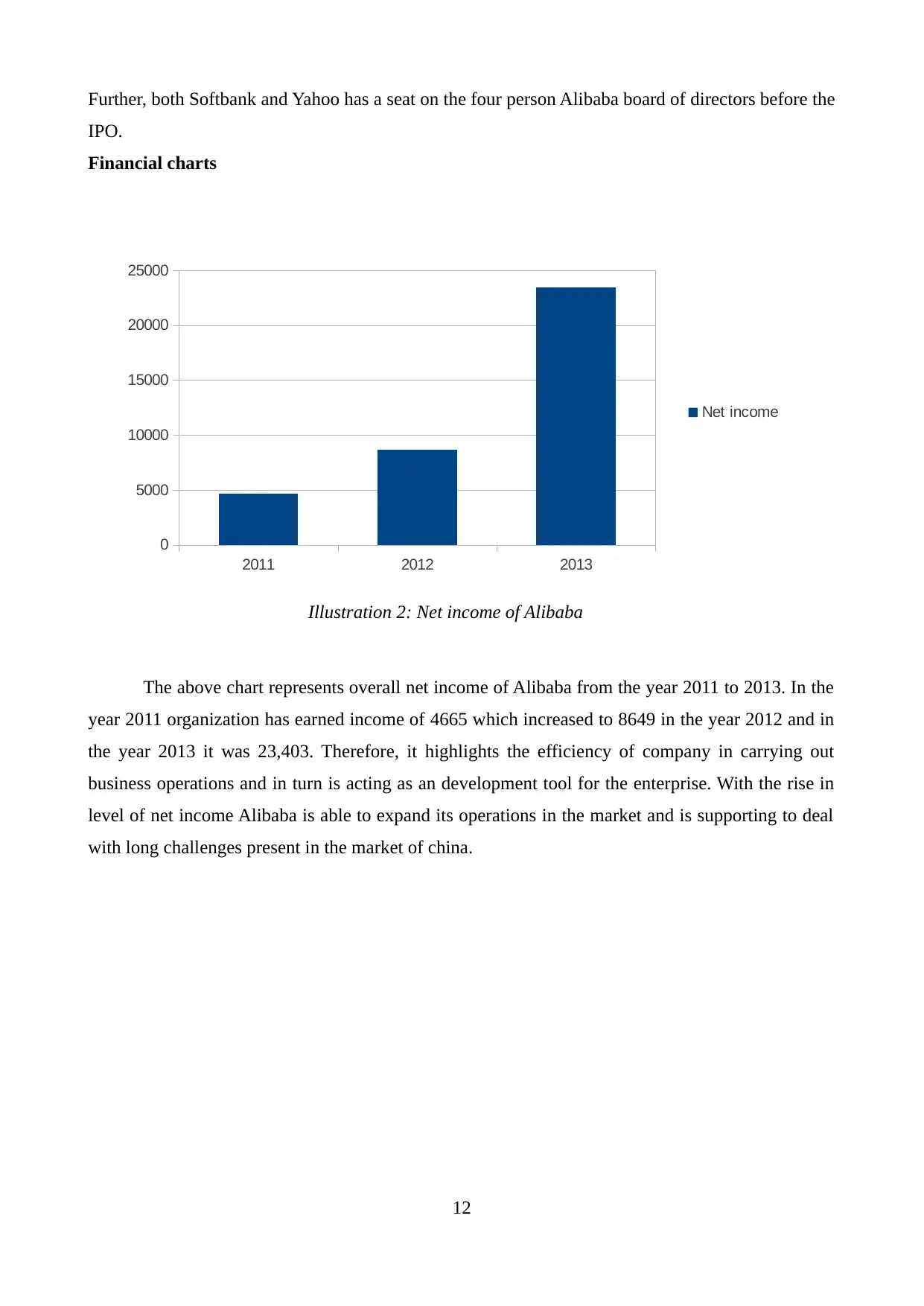
Further, both Softbank and Yahoo has a seat on the four person Alibaba board of directors before the
IPO.
Financial charts
The above chart represents overall net income of Alibaba from the year 2011 to 2013. In the
year 2011 organization has earned income of 4665 which increased to 8649 in the year 2012 and in
the year 2013 it was 23,403. Therefore, it highlights the efficiency of company in carrying out
business operations and in turn is acting as an development tool for the enterprise. With the rise in
level of net income Alibaba is able to expand its operations in the market and is supporting to deal
with long challenges present in the market of china.
12
2011 2012 2013
0
5000
10000
15000
20000
25000
Net income
Illustration 2: Net income of Alibaba
IPO.
Financial charts
The above chart represents overall net income of Alibaba from the year 2011 to 2013. In the
year 2011 organization has earned income of 4665 which increased to 8649 in the year 2012 and in
the year 2013 it was 23,403. Therefore, it highlights the efficiency of company in carrying out
business operations and in turn is acting as an development tool for the enterprise. With the rise in
level of net income Alibaba is able to expand its operations in the market and is supporting to deal
with long challenges present in the market of china.
12
2011 2012 2013
0
5000
10000
15000
20000
25000
Net income
Illustration 2: Net income of Alibaba
⊘ This is a preview!⊘
Do you want full access?
Subscribe today to unlock all pages.

Trusted by 1+ million students worldwide
1 out of 50
Related Documents
Your All-in-One AI-Powered Toolkit for Academic Success.
+13062052269
info@desklib.com
Available 24*7 on WhatsApp / Email
![[object Object]](/_next/static/media/star-bottom.7253800d.svg)
Unlock your academic potential
Copyright © 2020–2025 A2Z Services. All Rights Reserved. Developed and managed by ZUCOL.




